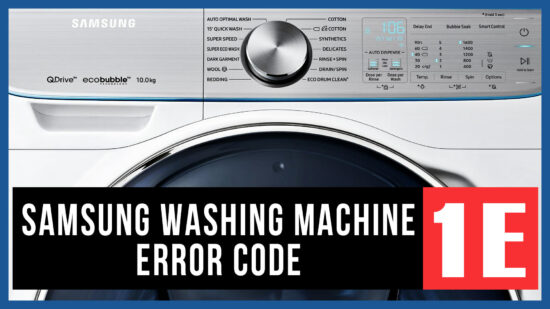Samsung washing machines are renowned for their quality and reliability, but like any appliance, they can occasionally encounter errors. One common error that users may come across is Error 1E.
If you're facing this issue, don't worry. In this article, we will explore what Samsung washing machine Error 1E means, its possible causes, and the steps you can take to troubleshoot and resolve the problem.
Understanding Samsung Washing Machine Error 1E
Error 1E on a Samsung washing machine typically indicates a water inlet error. It means that the machine is having difficulty filling up with water during the wash cycle. This error code can appear on various models of Samsung washing machines and can be identified by the digital display on the machine.
Possible Causes of Error 1E
Several factors can lead to the occurrence of Error 1E on your Samsung washing machine. Understanding the potential causes can help you troubleshoot the issue effectively. Here are some common reasons:
Water Supply Issue: Insufficient water pressure or a problem with the water supply can trigger the Error 1E. Make sure that the water supply valves are fully open and that there are no kinks or blockages in the hoses.
Faulty Water Inlet Valve: A malfunctioning water inlet valve can prevent water from entering the washing machine properly, leading to the error. The valve may need to be cleaned or replaced.
Clogged Inlet Filters: If the inlet filters are clogged with debris or sediment, it can impede the flow of water into the machine. Regularly cleaning or replacing these filters can help prevent Error 1E.
Wiring Issues: Loose or damaged electrical connections between the water inlet valve and the control board can disrupt the water flow and trigger the error code.
Also read: How to resolve a Samsung washer 4c
Troubleshooting and Solutions
Now that we have identified some possible causes of Samsung washing machine Error 1E, let's discuss the troubleshooting steps you can take to resolve the issue:
Check the Water Supply: Ensure that the water supply valves connected to the machine are fully open. Additionally, inspect the water hoses for any kinks or blockages. If necessary, clean or replace the hoses.
Clean the Inlet Filters: Locate the inlet filters on the back of the washing machine. Disconnect the hoses and remove the filters. Clean them thoroughly under running water to remove any accumulated debris. Once cleaned, reattach the filters and reconnect the hoses.
Inspect the Water Inlet Valve: Examine the water inlet valve for any signs of damage or malfunction. If it appears faulty, consider replacing the valve. Consult the user manual or contact Samsung customer support for guidance on replacing the part.
Check the Wiring Connections: Carefully inspect the wiring connections between the water inlet valve and the control board. Ensure that they are secure and free from damage. If you notice any loose or damaged wires, consider contacting a professional technician to repair or replace them.
Restart the Machine: After performing the necessary checks and fixes, restart the washing machine to see if the Error 1E is resolved. If the error persists, you may need to seek further assistance from Samsung's customer support or a qualified technician.
Also read: How to fix error code 3e on Samsung washing machine
Conclusion
Encountering an error code like 1E on your Samsung washing machine can be frustrating, but with the right troubleshooting steps, you can often resolve the issue on your own.
By understanding the possible causes of Error 1E and following the solutions outlined in this article, you can effectively troubleshoot and resolve the problem.
Remember to always refer to the user manual or seek professional help if needed. With these guidelines, you can get your Samsung washing machine back up and running smoothly, ensuring clean and fresh laundry every time.
Also read: E18 error Bosch washing machine
Also read: Samsung Washing Machine Error DC
FREQUENTLY ASKED QUESTIONS (FAQ)
How do I fix the 1E error on my Samsung washer?
To fix the 1E error on your Samsung washer read this article from starting.
What is Samsung fault code 1E?
Samsung fault code 1E on a washing machine indicates a water inlet error. It means that the machine is having difficulty filling up with water during the wash cycle. The error code is displayed on the machine's digital display, alerting the user to the specific issue.
What is the error code E01 on a washing machine?
The error code E01 on a washing machine can vary depending on the manufacturer. However, in many cases, it indicates a water inlet problem similar to Samsung's 1E error code.
The E01 error code signifies that the machine is experiencing difficulties in receiving an adequate water supply, which can prevent it from functioning properly.
How do I fix error code 1E on my LG washer?
To fix error code 1E on your LG washer, you can try the following steps:
Check the water supply: Ensure that the water supply valves connected to the machine are fully open and that the hoses are not kinked or blocked.
Clean the inlet filters: Locate the inlet filters on the back of the washing machine. Disconnect the hoses and remove the filters. Clean them thoroughly to remove any debris or sediment. Reattach the filters and reconnect the hoses.
Inspect the water inlet valve: Examine the water inlet valve for any signs of damage or blockage. If necessary, clean or replace the valve.
Verify the wiring connections: Check the wiring connections between the water inlet valve and the control board. Ensure they are securely connected and undamaged.
Restart the machine: After performing the necessary checks and fixes, restart the washer to see if the error code is resolved. If the problem persists, it is advisable to contact LG's customer support or a professional technician for further assistance.
Remember to consult your specific washer's user manual for accurate and model-specific instructions, or reach out to the manufacturer's support for additional guidance.
